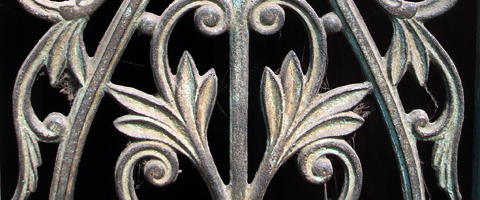
Most cities are designed to preserve memories, but memories, often, of other cities. Like many old colonial cities, Chandannagar was built to preserve memories of a past that never happened, or happened somewhere else, in some other part of the world: it is in the structures the French built, in the gaslights and the wide sidewalks, and even in spellings of names.
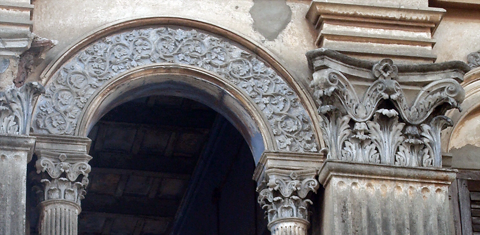
The city flourished and grew when the French moored their boats on the banks of the Ganges more than three centuries ago. Most structures from this era are of classical Greco-Roman styles of mixed orders. The buildings have tall columns with Corinthian capitals, some with Composite or Ionic ones, some with a marked Tuscan restraint. There are flourishes and vines, whose vegetal origins are alien to the native memory and geography. Somewhere, Romanesque Acanthus scrolls run along the friezes. Some fancy grille-works of mingled lineages here and there, now rust-riddled and peeling paint. And tall wooden windows with slatted blinds that make you strangely, vicariously nostalgic.
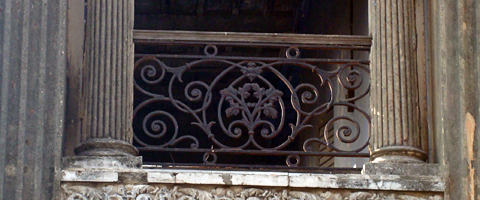
Now, the new structures are growing beside them and they jostle for elbow room. Sometimes you see how styles have fused over the years: how the Greco-Roman absorbs the oriental details in later buildings. Sometimes you find history exists in fragments, often muffled by the noise of the present. From time to time you see a stray scroll here, a motif there, or some fragment of a grille, among the ruins or a decaying structure, like an awkward syllable in a broken chain of expression.
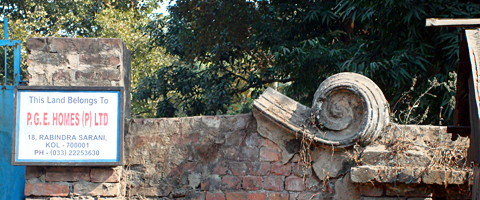
Like most colonial cities, the city and its structures have gone through strange reversals and revisions: a hotel may have become a court of law, a center of entertainment now a college, a large stable is now a hall for civic activities where exhibitions are held and poetry recited in the evenings. And thus one fiction replaces another in the same old narration of the city.

About 30 odd kilometers north of Kolkata, and placed along the banks of Ganges, Chandannagar is so small you could walk all of it if you have a couple of days to spare. While documenting the city and its structures, its signs and hoardings, there was an urge to discover bearings of the city and its designs on the shapes of letters that the place enunciates, something one knew from the outset was a wrong direction to pursue. But often you are tempted to find the echo of a cusped-arched doorway in the shape of a modifier, a terminal may remind you of an Ionic scroll from a capital. The flourishes and the ornaments that weigh on their letters may look reminiscent of the vines and leaves from the buildings. The city finds newer ways to remember itself or what it is supposed to remember.
![]()

Srimati Beauty Parlor, Chandannagar. © Rarh Design Studio 2011

Abhinandan, Chandannagar. © Rarh Design Studio 2011

Shiuli Sarees, Chandannagar. © Rarh Design Studio 2011

Tanushree, Chandannagar. © Rarh Design Studio 2011

Anjali, Chandannagar. © Rarh Design Studio 2011

Mandal Music, Chandannagar. © Rarh Design Studio 2011

Garden Tea, Chandannagar. © Rarh Design Studio 2011

Malakshmi Sweets, Chandannagar. © Rarh Design Studio 2011

Wool, Chandannagar. © Rarh Design Studio 2011

Sandhya Sweets, Chandannagar. © Rarh Design Studio 2011
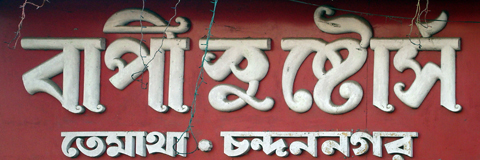
Bapi Shoe Stores, Chandannagar. © Rarh Design Studio 2011

Bastra Mahal, Chandannagar. © Rarh Design Studio 2011

Sweets Mrityunjay, Chandannagar. © Rarh Design Studio 2011
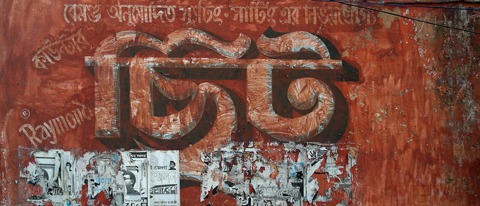
Chhit, Chandannagar. © Rarh Design Studio 2011
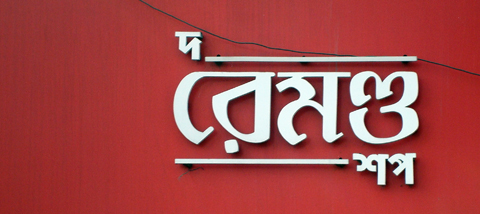
The Raymond Shop, Chandannagar. © Rarh Design Studio 2011

Rabindrabhavan, Chandannagar. © Rarh Design Studio 2011

Kamala Stores, Chandannagar. © Rarh Design Studio 2011

Tota, Chandannagar. © Rarh Design Studio 2011

Bhar Decorators, Chandannagar. © Rarh Design Studio 2011

Samir Hindu Hotel, Chandannagar. © Rarh Design Studio 2011
![]()
These signs and hoardings are from Chandannagar & the adjacent town of Mankundu. It was not possible to attribute the works to designers and painters involved: Rarh Design Studio regrets this. We are also greatly indebted to Shrabani Basu & Debangan Basu for their help and hospitality during our stay in the city.
Photographs: Shubho Roy & Prithwish Das
![]()
© Rarh Design Studio 2011
indy / 13 Aug 2011